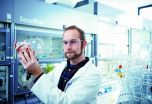River sediments, a dynamic reserve of pollutants
Researchers of the UPV/EHU-University of the Basque Country have located the origin of metals in the sediments of the River Deba and have assessed the effect that flood events have on them
2015-05-08
(Press-News.org) This news release is available in Spanish.
Metals are pollutants that have to be monitored in order to obtain a global overview of the quality of water systems, due to the fact that they remain in the environment. Although sediments act as a drain for pollutants, they can also act as a source of pollutants under certain environmental conditions (like changes in the composition of the water or movement of the sediments owing to a flood event). The UPV/EHU's Hydrology-Environment Group has conducted research on the River Deba and its tributaries to assess the influence of anthropogenic inputs and the effect exerted by major flooding events on the distribution of the metals associated with the sediments.
It is important to know the distribution of the pollutants in the soluble (water) and particulate (sediments) phases of rivers; this distribution is largely determined by the organic matter. As Estilita Ruiz, one of the group's researchers, explained, "whenever there is a change, the metal contained in the sediments can move from the particulate phase (associated with the sediment) to the soluble part (to the water), and that can increase the environmental hazard, the hazard for living beings".
The catchment area of the River Deba was chosen because it is one of the most polluted in Gipuzkoa. It is affected by major development linked to industry and population, and its resulting input of large quantities of industrial and municipal effluent. Another factor taken into consideration in this study was the mobilising of large quantities of sediments during the building of transport infrastructure, because it renders the effluent susceptible to being carried away by heavy rainfall.
What is present in the bottom sediments and how does it change?
Besides analysing the variations in the pollutants all along the riverbed of the River Deba and its tributaries (Ego and Oñati) from the headwater to the mouth in 2011 and 2012, the changes that took place in this catchment area over these two years ¬-both with respect to sewage management and to works taking place in the area, or flooding events occurring in that period of time- have led the group to establish the differences between the samples taken from two different hydrological years.
The collecting of fine sediment along the riverbed as well as the subsequent analysis of it in the laboratory have revealed that the main anthropogenic source of organic matter and metals is untreated or partially treated industrial and municipal effluent. This is reflected in the high organic load found in the sediments of the Ego stream, which until 2014 was receiving the untreated sewage of the municipality of Ermua. Yet the diversion of the organic effluent of the municipality of Oñati to the Epele treatment plant in 2012 has had a beneficial effect on sediment quality as its organic load has been considerably reduced and, as a result, so have the metals associated with these organic complexes. This means a reduced level of availability of these metals for the aquatic environment and, therefore, a reduced level of potential toxicity for aquatic life.
Besides the sewage, there are about a hundred medium-sized and large companies that contribute effluent rich in metals and they include electro-plating, metallurgy and foundry plants. The metals discharged by these factories are to be found in the fragments that are more susceptible to being released into the aquatic environment, should the physico-chemical conditions of the river change. In fact, turbulent flow conditions, like those arising during flooding events, could encourage the mobility and release of the metals associated with these sediments. So for all these reasons these metals need to be be monitored during these events.
Finally, they have concluded that in the River Deba catchment area there is a clear increase in the concentration of organic matter and metals between the headwater and the mouth "which provides proof for the relative non-polluted nature of the headwater streams with respect to the high pollution of anthropogenic origin in the middle and lower part of this river," explained the researcher. "The highly polluted sediments of the Ego stream reflect how far away it is from the optimum quality conditions that should be displayed by an overland stream. Furthermore, this stream has been found to exert a negative impact on the water quality of the River Deba into which it flows."
INFORMATION:
Additional information
The UPV/EHU's Hydrology-Environment research group (IT598-13) is a consolidated group of the Government of the Basque Autonomous Community (region), whose lead researcher is Iñaki Antigüedad (Professor of Hydrogeology). It is a multidisciplinary group in which there are research personnel from various fields of study, such as biology, geology, chemistry and chemical and environmental engineering. Within the lines of research, the study of metals in sediments and particulate matter during flooding events is being led by Estilita Ruiz-Romera, with the collaboration of researchers like Miren Martinez-Santos and pre-PhD fellows of the Department of Chemical Engineering and Environment of the Faculty of Engineering in Bilbao.
The work has been conducted thanks to funding from the Spanish Ministry of Science and Innovation ("Effect of floods in the transport of particulate material and associated pollutants towards coastal waters in catchment areas in the Basque Country", CGL2011-26236), and also from the Chartered Provincial Council of Gipuzkoa through various projects between the years 2012-2014: "Quantification of the level of sediments exported from the catchment areas of the Province of Gipuzkoa during 2012 and the characterisation of the pollutants in the sediment of the Oria and Deba catchment areas" and "Quantification of the levels of sediments exported from the catchment areas of the Province of Gipuzkoa. 2013".
References
M. Martínez-Santos, A. Probstb, J. García-García, E. Ruiz-Romera. "Influence of anthropogenic inputs and high-magnitude flood event on metal contamination pattern in surface bottom sediments from the Deba River urban catchment". Science of the Total Environment (STOTEN) 514, 10-25. 2015
ELSE PRESS RELEASES FROM THIS DATE:
2015-05-08
The most populated areas of Puget Sound have experienced striking shifts in marine species, with declines in herring and smelt that have long provided food for other marine life and big increases in the catch of jellyfish, which contribute far less to the food chain, according to new research that tracks species over the last 40 years.
The parallel trends of rising human population and declining forage fish such as herring and smelt indicate that human influences such as pollution and development may be eroding species that long dominated Puget Sound. In particular, the ...
2015-05-08
Hamilton, ON (May 7, 2015) - A team of researchers based at McMaster University has developed a new understanding of post-concussion syndrome, answering questions that have been plaguing researchers in the field.
Their study, published in the medical journal Brain, Behavior and Immunity, provides an explanation for why many people with even very trivial head injuries, or even injuries to other parts of their bodies, experience incapacitating post-concussion like syndromes.
These symptoms include headaches, dizziness, cognitive impairment and other neuropsychiatric symptoms ...
2015-05-08
Researchers have discovered a new gene that enables plants to regulate their growth in different temperatures.
Published in PLoS Genetics today, the finding could lead to new ways of optimising plant growth when it comes to climate change.
Associate Professor Sureshkumar Balasubramanian, from Monash University, along with colleagues in Spain, made the discovery after analysing natural populations of the model plant Arabidopsis thaliana, commonly known as thale cress.
"Plants are highly sensitive to environmental changes and even small changes in temperature impact ...
2015-05-08
Danish researchers at the University of Copenhagen have discovered how to map more than one protein at a time, when proteins repair damaged DNA. It is a discovery that will help accelerate the process of developing better and gentler cancer treatments. The discovery has just been described in an article in the renowned scientific journal, Science.
When DNA is damaged, several different proteins start pouring in to repair the damage; their types depend on the damage done. Up until now, it has been common practice to study one protein at a time, but by way of so-called ...
2015-05-08
Washington, DC (May 5, 2015) -- Dating apps like Tinder offer a quick look at a potential connection, with a simple swipe to either decline or accept the potential match. The stakes are high for putting the right picture in your profile. But does putting an enhanced picture of yourself increase the chance you'll make that match? Being cat-fished is a real risk and users have to take into consideration whether the picture of the person is "too hot to trust." A new study by researchers at the University of Connecticut found that enhanced photos of women viewed by men increased ...
2015-05-08
Ann Arbor, MI, May 8, 2015 - Certain regions in the United States are characterized by a higher prevalence of obesity, which suggests that a person's socioeconomic, physical, and social environments can affect opportunities for healthy behaviors that might prevent excess weight gain. But what happens when people move from one neighborhood to another? A new study published in the American Journal of Preventive Medicine found that people who moved to more socioeconomically deprived neighborhoods gained additional weight.
Researchers used data from the Dallas Heart Survey ...
2015-05-08
Ann Arbor, MI, May 8, 2015 - Children are exposed to a considerable amount of televised food advertising: more than six ads accounting for about 2:21 minutes per hour during typical programming. Concerns about the role of televised food advertising as a contributor to childhood obesity led to the food industry adopting of a program of self-regulation. A new study published in the American Journal of Preventive Medicine evaluated the effectiveness of industry self-regulation and found that this program has achieved little improvement in the nutritional quality of foods advertised ...
2015-05-08
Philadelphia, PA, May 8, 2015 - An important function of the human placenta is to protect the fetus from detrimental substances in maternal blood, such as glucocorticoids or toxins. Placental membrane-bound transporter proteins, known as multidrug resistance proteins, protect the fetus by returning unwanted materials to the maternal circulation. A study in The American Journal of Pathology reports that bacterial and viral infections differentially influence these transporter proteins in early and late pregnancy, suggesting potential mechanisms underlying infection-related ...
2015-05-08
The Sun is a huge source of energy. In just one hour planet Earth is hit by so much sunshine that humankind could cover its energy needs for an entire year if only we knew how to harvest and save it. But storing sunshine is not trivial. Now a student at Department of Chemistry, University of Copenhagen has researched his way to a breakthrough which may prove pivotal for technologies trying to capture the energy of the sun, and saving it for a rainy day.
Anders Bo Skov has recently started studying for his Master's degree in chemistry at University of Copenhagen. Together ...
2015-05-08
Switching from driving to work to using public transport, walking, or cycling might help commuters shed weight within a couple of years, suggests research published online in the Journal of Epidemiology & Community Health.
Given that car use is high, the findings strengthen the case for incentivising walking or cycling to boost population health, suggest the researchers.
They base their findings on the responses of 4000 people to three waves of the British Household Panel Survey (BHPS) in 2004-5, 2005-6, and 2006-7.
The BHPS is a long term annual study of a representative ...
LAST 30 PRESS RELEASES:
[Press-News.org] River sediments, a dynamic reserve of pollutants
Researchers of the UPV/EHU-University of the Basque Country have located the origin of metals in the sediments of the River Deba and have assessed the effect that flood events have on them

